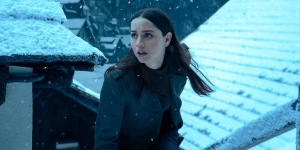DEMON SLAYER INFINITY CASTLE (2025) – An Epic Clash of Swords, Spirits, and Artistic Brilliance
Rating: ⭐⭐⭐ 1/2

Demon Slayer Infinity Castle (2025) arrives with thunderous anticipation, beckoning both die-hard fans and newcomers alike into its relentless, kaleidoscopic world. Although I confess to not being a seasoned follower of the Demon Slayer manga, this latest cinematic chapter needs no passport to sweep viewers along its torrent of action and emotion. A brief primer in the series’ lore—more than a luxury, less than a necessity—will certainly help orient those uninitiated, allowing them to savor the film’s intricacies rather than feeling adrift amidst its swirling chaos.
From its humble origins as an anime television series in 2019, Demon Slayer has evolved into a cultural phenomenon, spawning the blockbuster Mugen Train (2020), followed by a trio of acclaimed seasons: Entertainment District (2021), Swordsman Village (2023), and Hashira Training (2024). Now, the Infinity Castle Arc launches what promises to be a grand trilogy, unfurling the saga’s climactic confrontation. The plot follows the Hashira, an elite cadre of demon slayers tasked with defending humanity from the demonic scourge—once-human monsters transformed by Muzan, the enigmatic demon king. These demons, vampiric in their aversion to sunlight and zombie-like in their vulnerability to decapitation (with a twist of regenerative prowess), haunt the labyrinthine Infinity Castle, ever shifting in structural madness to foil the Hashira’s advance.
What distinguishes Infinity Castle is not merely its narrative stakes but its sheer cinematic spectacle: the animation dazzles, the action is breathless, and fight choreography borders on balletic. Each battle is a high-wire act, interwoven with character backstories and psychological asides, delivered in a torrent of subtitles that demand quick wits and attentive eyes—yet reward with emotional depth and narrative dimension.
Foremost among these is the climactic duel between Tanjiro, the series’ moral anchor, and Akaza, one of Muzan’s most formidable lieutenants. The clash is not just a test of strength, but an emotional crucible, as flashbacks reveal Akaza’s tragic transformation from human to demon. In true Demon Slayer fashion, the film refuses to paint its antagonists in monochrome, inviting empathy and reflection even as swords flash and blood flies.
Infinity Castle stands as a singular achievement—an immersive fantasy unburdened by overt politicking or gratuitous content, a testament to pure escapism and creative vision. Its popularity is no accident; it’s a celebration of myth, artistry, and the age-old struggle between shadow and light. Credit goes particularly to the film’s main director Haruo Sotozaki and writer Koyoharu Gotuuge. For those seeking a cinematic experience that is as exhilarating as it is unexpectedly profound, Demon Slayer Infinity Castle is a triumph—and easily one of the year’s highlights.


